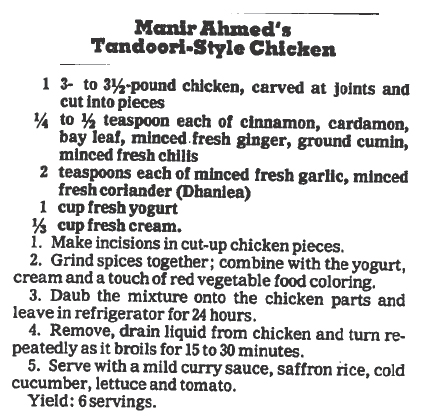Little India in the East Village
Many people know that the East Village is abundant with Ukrainian restaurants and Eastern European lunch counters. They also know that there are plenty of old-school Italian joints to get some authentic red sauce or cannolis. But another part of the East Village’s mouth-watering culinary heritage is its own Little India– a block of 6th Street between 1st and 2nd Avenues that is filled with mouth watering curry (the block is also sometimes referred to as Curry Row).

It all started in 1968 with Manir Ahmed and his five brothers, all recent immigrants from East Pakistan (present-day Bangladesh). They were living on the Lower East Side and wanted to create a place where they could find the food they were used to. The brothers noticed a small Japanese restaurant for sale on East 6th Street for $2,000 that came with tables and equipment. However, they only were able to come up with $1,800. The seller accepted. They were drawn to the area for its low rents, only $75/month at the time. The oldest brother, Moin, cooked the food and the storefront started out as just a place for the brothers to eat and gather with friends. Before long, though, passersby kept knocking on the door asking if they were restaurant. So, the brothers decided they should open one.
Their first official restaurant, Shah Bag, opened at 320 East 6th Street later that same year. Two years later Kismoth opened at # 330. In 1976 a waiter from Shah Bag opened Romna at #322. In 1978 the brothers opened three more restaurants, and then three again in 1979. In the early 1980’s East 6th Street exploded, due in part to the loosened Asian immigration restrictions that brought thousands of Bangladeshis to New York.

The restaurants were cooperatives, sharing the cost of imported spices, buying rice jointly by the carload, lending chefs to one another, and exchanging waiters. Interestingly, although the street came to be known as “Little India,” the Ahmed brothers’ establishments were and still are Bangladeshi, not Indian, which is why they serve beef and not pork. Others that sprouted up with different owners, like the very popular Brick Lane Curry House, are Indian. Before long, the brothers started purchasing the buildings in which their restaurants were housed and by the 1990’s there were 30 Bengali/Indian restaurants on this one block. Another interesting side note- the owners and employees that worked on Curry Row were responsible for the founding of the mosque on 11th Street.

A 2004 New York Times article focused on the closing of so many of these restaurants due to gentrification and rising rents. Today only 9 remain on East 6th Street. There are also 4 more around the corner on 1st Avenue- the Pannas and Milons. You may know Panna I and II and Milon (read more about their “rivalry” in this Villager article) from their square configuration and blinking lights. In fact, their website describes their aesthetic as, “where chili pepper lights meet Christmas lights.” One reason that Little India is popular today is that the restaurants are BYOB, a feature hard to find in Manhattan, and one that will hopefully keep these remaining local businesses thriving. So next time you’re looking for some spicy south Asian cuisine, look no further than East 6th Street!


Wonderful and fascinating article but I think you mean “Bangladeshi” when you write “Bengali”- the former being an ethnicity (there are both Indian and Bangladeshi Bengalis) and the latter being a nationality.
I grew up eating in these places most nights and greatly enjoyed the food and excellent live music too. The Bangladeshi community in the East Village has a rich and vibrant legacy.
Yes, thank you so much for that correction!
And now there’s a Sri Lankan place on 1st Avenue, near the two Pannas.
I’m the younest daugther of Manir Ahmed. I have been always very proud of my father. Reading this artile has made me realize i can never live up to him. But i hope someday i can become half the person he was or still is. Not only he had a successful restaurant carrer in USA, he is a very succesful banker here in Bangladesh too. Now he is in his 80’s. For the past few days he has been bugging me to show him an article about him from the 70’s i guess on new york times. Insted i wond up here. Thank you 🙂
Hi Dana, I love this article! I noticed that you referenced a 2004 New York Times Article about gentrification and rising rent prices in Little India. I was wondering if you could send the link to that article? The link that you put in your post leads me to ProQuest, and I cannot access the article there. I am a high school student doing a project on Little India and it would help me a lot! Thank you!